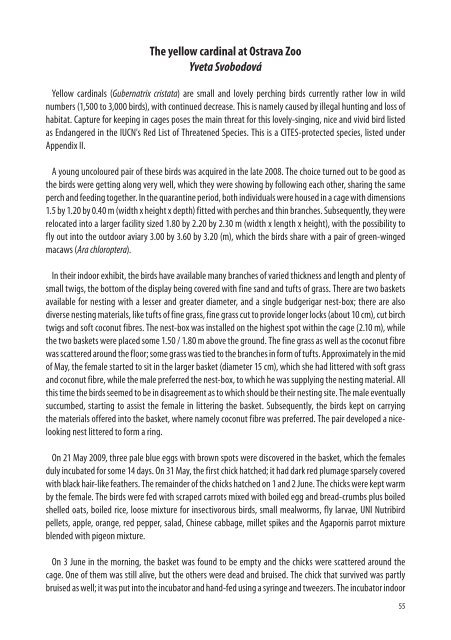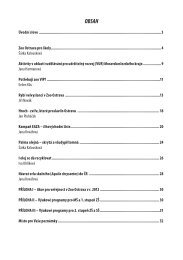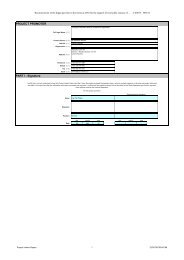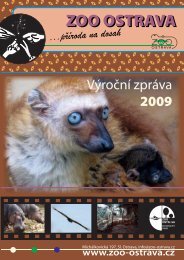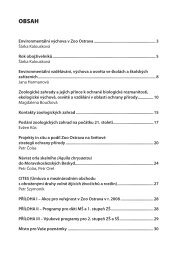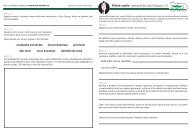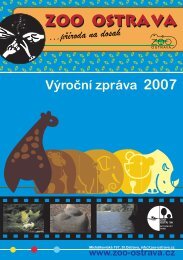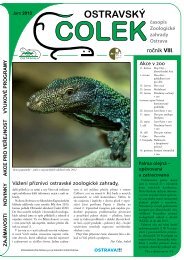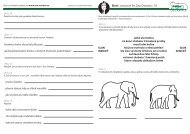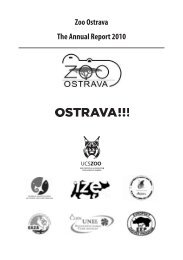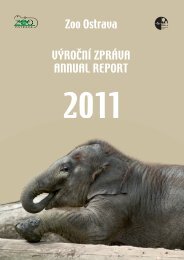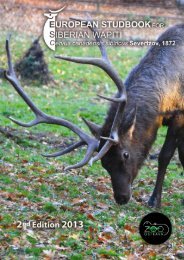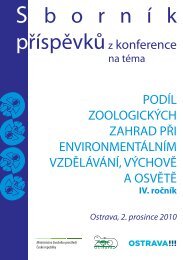You also want an ePaper? Increase the reach of your titles
YUMPU automatically turns print PDFs into web optimized ePapers that Google loves.
<strong>The</strong> yellow cardinal at <strong>Ostrava</strong> <strong>Zoo</strong><br />
Yveta Svobodová<br />
Yellow cardinals (Gubernatrix cristata) are small and lovely perching birds currently rather low in wild<br />
numbers (1,500 to 3,000 birds), with continued decrease. This is namely caused by illegal hunting and loss of<br />
habitat. Capture for keeping in cages poses the main threat for this lovely-singing, nice and vivid bird listed<br />
as Endangered in the IUCN's Red List of Threatened Species. This is a CITES-protected species, listed under<br />
Appendix II.<br />
A young uncoloured pair of these birds was acquired in the late 2008. <strong>The</strong> choice turned out to be good as<br />
the birds were getting along very well, which they were showing by following each other, sharing the same<br />
perch and feeding together. In the quarantine period, both individuals were housed in a cage with dimensions<br />
1.5 by 1.20 by 0.40 m (width x height x depth) fitted with perches and thin branches. Subsequently, they were<br />
relocated into a larger facility sized 1.80 by 2.20 by 2.30 m (width x length x height), with the possibility to<br />
fly out into the outdoor aviary 3.00 by 3.60 by 3.20 (m), which the birds share with a pair of green-winged<br />
macaws (Ara chloroptera).<br />
In their indoor exhibit, the birds have available many branches of varied thickness and length and plenty of<br />
small twigs, the bottom of the display being covered with fine sand and tufts of grass. <strong>The</strong>re are two baskets<br />
available for nesting with a lesser and greater diameter, and a single budgerigar nest-box; there are also<br />
diverse nesting materials, like tufts of fine grass, fine grass cut to provide longer locks (about 10 cm), cut birch<br />
twigs and soft coconut fibres. <strong>The</strong> nest-box was installed on the highest spot within the cage (2.10 m), while<br />
the two baskets were placed some 1.50 / 1.80 m above the ground. <strong>The</strong> fine grass as well as the coconut fibre<br />
was scattered around the floor; some grass was tied to the branches in form of tufts. Approximately in the mid<br />
of May, the female started to sit in the larger basket (diameter 15 cm), which she had littered with soft grass<br />
and coconut fibre, while the male preferred the nest-box, to which he was supplying the nesting material. All<br />
this time the birds seemed to be in disagreement as to which should be their nesting site. <strong>The</strong> male eventually<br />
succumbed, starting to assist the female in littering the basket. Subsequently, the birds kept on carrying<br />
the materials offered into the basket, where namely coconut fibre was preferred. <strong>The</strong> pair developed a nicelooking<br />
nest littered to form a ring.<br />
On 21 May <strong>2009</strong>, three pale blue eggs with brown spots were discovered in the basket, which the females<br />
duly incubated for some 14 days. On 31 May, the first chick hatched; it had dark red plumage sparsely covered<br />
with black hair-like feathers. <strong>The</strong> remainder of the chicks hatched on 1 and 2 June. <strong>The</strong> chicks were kept warm<br />
by the female. <strong>The</strong> birds were fed with scraped carrots mixed with boiled egg and bread-crumbs plus boiled<br />
shelled oats, boiled rice, loose mixture for insectivorous birds, small mealworms, fly larvae, UNI Nutribird<br />
pellets, apple, orange, red pepper, salad, Chinese cabbage, millet spikes and the Agapornis parrot mixture<br />
blended with pigeon mixture.<br />
On 3 June in the morning, the basket was found to be empty and the chicks were scattered around the<br />
cage. One of them was still alive, but the others were dead and bruised. <strong>The</strong> chick that survived was partly<br />
bruised as well; it was put into the incubator and hand-fed using a syringe and tweezers. <strong>The</strong> incubator indoor<br />
55


